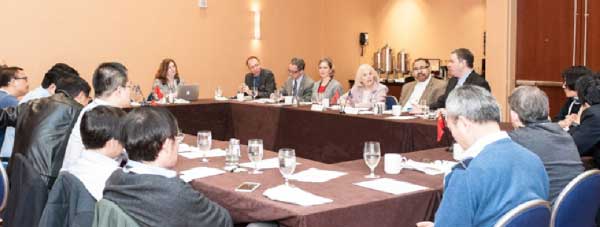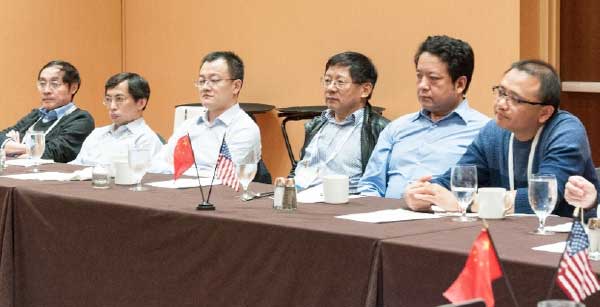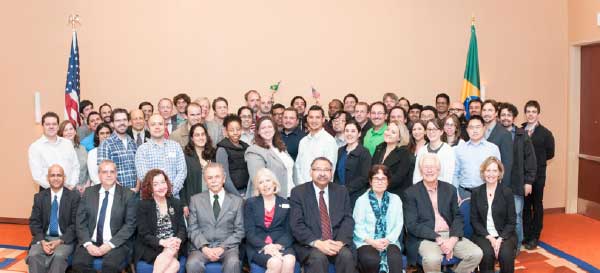Report from the APS International Affairs Office (INTAF)
Amy Flatten
It is a pleasure to convey a few highlights of our international activities that we have undertaken since those described in the spring 2016 FIP newsletter. From past articles and advertisements, I hope you are all aware of, and perhaps availing yourselves of some of the opportunities in our portfolio of ongoing sustainable international programs. These include our travel award programs with Brazil and India, the Marshak & Beller Lectureships, and IRTAP, the International Research Travel Award Program. More information on these is available on our website. I would like to use this article, however, to highlight a few “special events” since this past spring. These represent just a few of our efforts to strengthen our connections and serve physicists around the globe.
Lebanon
This past spring, APS launched its first call for proposals for a professorship/lectureship program for physicists in Lebanon and the United States. The Académie des Sciences du Liban (ASL) and the American Physical Society (APS) signed a Memorandum of Understanding to support scientists wishing to visit the United States or Lebanon.
The professorships/lectureships consist of a short course or a lecture series (three or more lectures) delivered at Lebanese or U.S. institutions. The applications required a joint proposal from the visiting professor and the host professor for the short course or lecture series. Those proposals with research activities that complemented the lectures were given higher priority. I am pleased to announce the following initial recipients of this award:
- Dr. Maher A. Dayeh, Space Science & Engineering Division, Southwest Research Institute; San Antonio, Texas, United States. Dr. Dayeh will conduct a series of five lectures on magnetic reconnection at the American University of Beirut (AUB) in October 2016.
- Dr. Jihad R. Touma, Department of Physics, American University of Beirut; Beirut, Lebanon. Dr. Touma will give a series of 3 to 4 lectures over two weeks at the California Institute of Technology entitled “From Multiplanets in Binaries to Stellar Black Hole Nuclei: A Leisurely Overview of Secular Dynamics in Near-Keplerian Systems.”
The APS has been strengthening its links to the physics community in the Middle East. We hope that this program will be very helpful in establishing closer relations and building networks in Lebanon, as well as serving to build scientific capacity in the region. We wish to congratulate the award recipients and wish them great success.
Cuba
Last March, Laura Greene (APS President-Elect) and I traveled to Havana to meet with the Direction Board of the Sociedad Cubana de Física (SCF), following an invitation by María Sánchez-Colina, President of the SCF.

Photo: Cuban Physical Society
A meeting between leaders of the Cuban Physical Society (SCF) and the American Physical Society (APS). From left to right: Ernesto Altshuler (Editor of the Revista Cubana de Física), Laura Greene (President-elect, APS), María Sánchez-Colina (President, SCF), Amy Flatten (Director of International Affairs, APS), Juan G. Darias (Vice-president for organizational affairs, SCF), Luis Méndez-Pérez (Vice-president, SCF), Alejandro Cabo (Vice-president, SCF) and Aurora Pérez (Vice-president for financial affairs, SCF). Picture taken on March 8, 2016, at the Colegio Universitario San Gerónimo de La Habana (Picture: courtesy of San Gerónimo’s staff)
The meeting took place at the Colegio Universitario San Gerónimo de La Habana and explored needs and interests of the Cuban Physical Society for a partnership with APS. The Cuban physicists identified 3 main goals of SCF-APS cooperation:
- Connecting young Cuban physicists with their U.S. counterparts
- Inviting senior US physicists to teach courses in Cuban universities
- Finding ways to collect equipment donations and send them to Cuban physics institutions
The APS has concrete plans for addressing each of these goals in the upcoming year. In 2017, APS will host a meeting of North American and Cuban physics graduate students in Washington, D.C. It also has established programs for sending senior physicists to Brazil and India, and hopes to use that as a model for future Cuban programs. The Society is also working with other scientific organizations toward collecting equipment donations and finding possible ways to transport them to Cuba—a complicated endeavor, given possible U.S. restrictions or regulations, despite renewed U.S.-Cuban diplomatic relations.
China
At the 2016 March Meeting, the APS leaders held fruitful discussions with the Chinese Physical Society (CPS) and leaders from Chinese universities. These “CPS-APS Leaders Breakfast” meetings began in 2012, and given the positive response from the Chinese participants, they have continued annually. The meetings provide an opportunity to informally discuss editorial concerns and interests, as well as proposals for joint activities. The meeting was hosted by the APS President Homer Neal and included ~ 22 leaders from CPS and APS, including the APS CEO Kate Kirby, the new APS Publisher Matthew Salter, Deputy Secretary-General of the CPS Dongmei-Gu, and physics leaders from Chinese universities and institutes. Following last year’s successful U.S.-China Young Physicists Forum, Chinese colleagues suggested several ideas for new joint programs. These included: 1) senior U.S. professors teaching a semester in Chinese universities, 2) sending U.S. undergraduate and graduate students to study in China, and 3) organizing a meeting of leaders of the physics departments from several Chinese and U.S. universities during the March Meeting. APS is following up on these ideas through its Committee on International Scientific Affairs (CISA).

Photo: Ken Cole, APS
APS President Homer Neal leads discussions at the CPS-APS Leaders breakfast.

Photo: Ken Cole, APS
Physics leaders from Chinese universities and institutes participate in CPS-APS leaders Breakfast
Brazil
In partnership with the Brazilian Physical Society (SBF) and the São Paulo Research Foundation (FAPESP), APS co-sponsored the U.S.-Brazil Young Physicists Forum (YPF) the weekend before the 2016 APS March Meeting in Baltimore, MD.
This event was specifically dedicated to postdocs, as well as early-career physicists in permanent positions, in the United States and Brazil (i.e., any physicists who have obtained their PhD within the past 10 years). The Forum focused on helping attendees build international and interdisciplinary networks and provided participants with networking, scientific presentations, and social events with leading Brazilian and American physicists working in academia and industry.
During the day and a half meeting, eminent senior physicists presented plenary talks to the early-career physicists, followed by parallel sessions with the participants themselves presenting to each other. Two panel discussions focused upon professional development and career-building: “University-Industry Collaboration in Research in the U.S. and Brazil” and “Life as a Young Physicist in Brazil and the United States.” Likewise, a lively poster-session/networking-reception allowed early-career physicists to discuss their research with international peers, industry leaders, and distinguished VIPs from the São Paulo Research Foundation, APS and SBF.
Leaders from both physical societies participated, including, APS President Homer Neal 2016 and APS CEO Kate Kirby. APS President-Elect Laura Greene gave a session on “Publishing in Peer-Reviewed Journals.” Likewise, both the President and Vice President of the Brazilian Physical Society, Roberto Galvão, and Belita Koiler, gave plenary talks, along with 2014 APS President Malcolm Beasley, and APS Vice-President, Roger Falcone.

Photo: Ken Cole, APS
Participants in U.S.-Brazil Young Physicists Forum.
Throughout the YPF, the young physicists discussed their work with potential partners and international colleagues in a smaller, more intimate setting than the larger 2016 March Meeting would have allowed. We hope that the relationships formed at this conference can last throughout the participants' professional lives, as they continue to attending APS or SBF annual meetings, and other international conferences in related subfields. Hopefully, the U.S.-Brazil Young Physicists Forum leads to many fruitful interdisciplinary and/or international networks and collaborations throughout the participants’ careers.
Dr. Amy Flatten is Director of International Affairs at the American Physical Society

Amy Flatten
